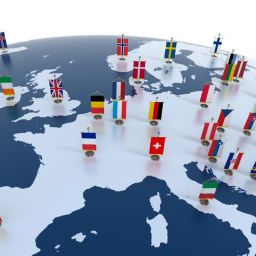
There’s a lot to consider when it comes to international expansion into foreign markets. Despite establishing the perfect product for our existing markets, that doesn’t guarantee your current business model or business plan will work equally well across global markets.
Even with existing products that we think should have a fluid international market share, cultural differences, technological and digital progress, and international trading laws have a huge impact on creating the desire, the sales, and the ease to trade in other markets.
Breaking into new markets and fine-tuning your expansion plan requires understanding, something we here at UX24/7 help many product managers, designers, and researchers dig deeper into to help them deliver a competitive advantage.
Every market brings its own unique challenges, so it’s essential to plan ahead and conduct market research accordingly. We must investigate customer behaviors, beliefs, attitudes, and practices to locate our target audience and understand how to ensure they’ll buy and remain loyal to our products and services.
Exploring the risks associated with new product development in a foreign market
We recently interviewed design researchers in various international markets to explore how different countries and company structure varies while using digital products and services. Given the incredible pace that technology is advancing, we found that we can’t afford to make assumptions about how buyers and businesses operate in other countries, and, from our findings, we were right to do so.
It wasn’t too big a surprise to see the cultural differences between the developing world and Western consumers, which we’ll talk about in a moment, but we also found plenty of factors and industry trends between neighboring countries that might surprise you.
Expanding into a target market in developing countries
There’s a lot to unpack for companies breaking into developing countries. The United Nations delivered a trade and development paper on the implications of national and international policy around digital platforms in such areas.
It’s a fascinating read, highlighting many points of interest around the vast cultural differences and how digitalization isn’t just transforming value chains for those opening new channels but structural transformation.
Our key areas to note involve exploring local competition, cross-border commerce, and cross-border data flows.
Local competition
For UX designers and researchers, understanding the value that various digital platforms—so easily attainable in the Western world—would deliver to developing countries yet to embrace them would provide huge benefits. This boost to infrastructure could aid local and regional markets to expand far further afield, yet local knowledge is still essential to boost consumer relationships and understand how best to offer better services to local users.
Cross-border commerce
To bridge the digital services gap between these markets, introducing cross-border commerce must deliver easier access to the many payment platforms and integrated e-commerce solutions. This is a vital area where companies don’t have access to the type of account that allows them access to foreign bank trading or even to advertising platforms in their native languages.
Cross-border data flows
Once again, we’re looking into data use and protection. With the digital world operating much more efficiently on data-driven decision-making, there’s a question of ownership regarding the data coming out of those countries and its value. Data is a major economic resource across the digital economy, so who controls it internationally is a contentious issue. Currently, the platform gathering the data has full control and can monetize it as it sees fit. For any country or Government wishing to exercise control over such data and its value, it would mean setting cross-border boundaries, and important ones, given the possible risk to national security, international surveillance, or from the risk of hacking.

Considering a target market in neighboring countries
While we too often believe our closest international neighbors will likely operate similarly to our existing customers, it’s rarely the case that any two countries will operate on the same beliefs, behaviors, and practices.
For example, during the interviews mentioned earlier (you can find the full piece on medium.com), we found differences that we regularly see and expect, the known-knowns, as we call them, and a range of other observations unique to specific research in a determined area.
Of the known-knowns, for example, we know that in Germany, its people are far more focused on their personal data than in other nations. Where many countries are relatively ambivalent about what happens to their information, Germans are far more focused on where it goes after submitting it and who has access to it. To show how this can differ between countries, the practice is practically nonexistent in Greece.
The Germans are one of the leading world economies (the largest in Europe and the fourth-largest globally) and are a popular market to break for any brand. With generous disposable incomes and a huge 90% internet penetration, lifestyle, fashion, home, and electronics have become popular segments for e-commerce.
For Germany’s European neighbors, it’s even better news, as their openness to cross-border e-commerce makes the transition far more straightforward. However, as customers, Germans are hard to excite, so don’t expect overwhelming feedback as you conduct your research.
The British, by comparison, seem far more impatient, avoiding form-filling and bureaucracy where possible, often jumping ship to an alternative site with an easier way of getting the results they need.
However, it’s worth noting that German consumers aren’t just concerned about where their data goes but also about the sustainability of their purchases. They hold strong concerns for the environment and eco-friendly products, so brands need to be aware of material choices, packaging, transport, and production processes if they’re going to appeal to that end of their cultural stance.
In the broader market, we found that there isn’t one standard of how consumers in different countries choose to buy. For example, Spain has been slow to embrace e-commerce. With less urban sprawl, Spanish buyers tend to have an abundance of shops within walking distance and a reticence to using credit cards online. Turkey is in direct contrast, as their buyers don’t want to leave home to make their purchases but buy everything online and have them delivered by courier.
Attempting to target customers in other countries means more than simply converting your marketing messages into other languages; the smart business will explore the many cultural and legal differences between their home country and any new location. Understanding those differences is often the difference between a successful integration into a new international market and failing.
Evaluating the current market against target markets
For those considering expanding into new markets, it pays to do your market research due diligence into the differences between your current customers’ cultures and habits and the legal and international aspects most likely to affect brand names, operations, and systems.
- Analyzing the current customer base
- Examining the existing product line
- Determining potential new customers in foreign markets
- Assessing the competition in international markets
Exploring the differences will help to determine a road map for a successful transition, minimizing the unforeseen issues that international UX research is designed to help you avoid.
Creating a new name and visual identity
Analysis and testing within your target audience allow you to determine your ideal brand identity for all new markets.
- Choosing an appropriate name
- Constructing a corporate image around the brand
- Designing logos and graphics to represent the brand
- Developing a complete brand overhaul strategy
Remember, it’s not only language that differs between markets but the psychology around color, iconography, type, placement, and imagery.
The benefits of a new name in a local market
Keeping an established name allows a brand to trade off any established success. However, there are legal reasons to consider (trademark and intellectual property issues) and those around marketing strategies, where a brand identity or product name is a bad fit for a new target market.
Here are a few examples of language and cultural differences where a name change became necessary after some basic market research:
- Coca-Cola changed Diet Coke to Coke Light in certain Mexican and EU markets where the word diet didn’t translate into low-calorie food.
- Kentucky Fried Chicken moved away from their original name and towards KFC to reduce the use of the word fried in locations where it was considered an unhealthy cooking process and to remove Kentucky, which was registered in the Commonwealth of Kentucky, and the state demanded larger user fees. Also, they made another significant change in Quebec, where businesses have to name their operations in the local language, making them Poulet Frit Kentucky.
- Lynx, the deodorant brand, was originally launched as Axe in France but had to be renamed in several other markets due to trademark legislation.
- The Honda Fitta was renamed the Honda Fit and Honda Jazz across Europe as in Swedish Honda Fitta translated as Honda Vagina.
- Both Apple Computer and International Business Machines invested in name changes of the simplified Apple and IBM after expanding into new products that didn’t fit their existing company names.
Finding a perfect name that works from country to country isn’t always as simple as it first seems. Tracking down a suitable naming convention that translates appropriately across borders and without negative connotations is a challenge for all levels of business, not just the big brand names.
Summary
Regarding global markets, brands and businesses need to be aware of the pitfalls they might never have imagined without the correct market research and cross-cultural, legal, and platform exploration. UX design can guide you successfully through every stage of your transition: from developing a brand name and business plan to navigating the social channels and advertising platforms appropriate to your new market, whatever the industry, size, or operation. Knowing your neighbor will help you to avoid miscalculations and mistakes, setting you on the right path to success and your most favorable results.
If you’re developing products for new or unfamiliar markets and would like to know more about how to align them with your customers and users needs email us at hello@ux247.com.
















